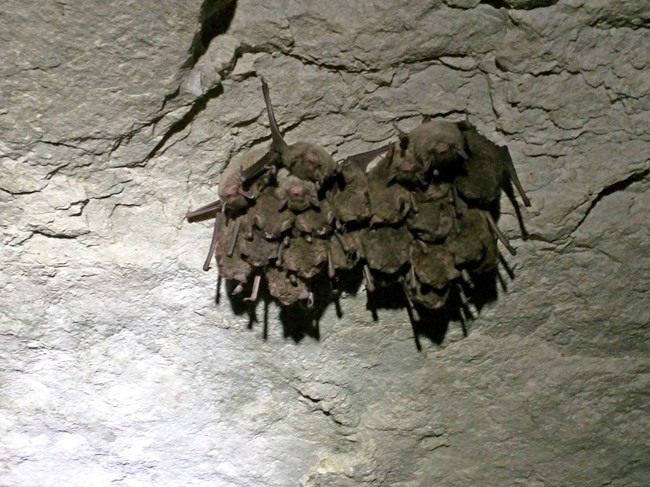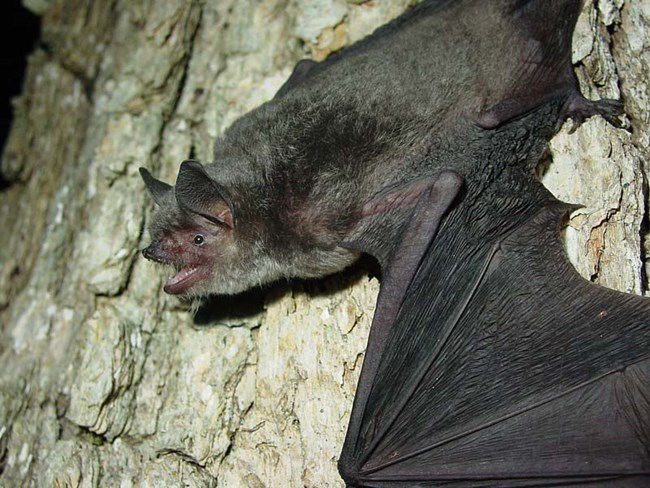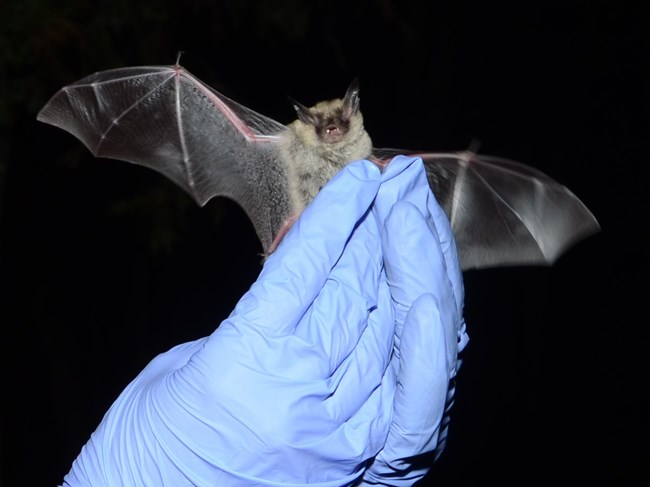Last updated: March 10, 2023
Article
Bats: Endangered Species of Mammoth Cave
Mammoth Cave National Park is home to a total of 13 species of bats, three of which are are listed on the federal endangered species list. These species include the Indiana bat, the gray bat, and the northern long-eared bat. The survival of these species has been especially impacted by the effects of White-nose Syndrome (WNS).

USFWS Photo
Threatened and Endangered Bat Species
Indiana bat Myotis sodalis
Status: Endangered, listed in 1973.
Populations of Indiana bats spend the winter hibernating in at least six caves within the park. Every two years the park conducts bat surveys, by carefully entering these sites to count the number of bats hibernating in the cave. Park scientists share bat survey results with other federal and state biologists who track the population of Indiana bats across its range which includes much of the Eastern part of North America.
During the summer female Indiana bats utilize trees to raise their pups, by using hollows in the trees or roosting under loose bark.
Around 2005, Indiana bat populations seemed to be stabilizing, but then the arrival of WNS to North America exacerbated species mortality rates. Since this time Indiana bats have been killed in large numbers by WNS, populations have again fallen dramatically, and they are critically endangered.

USFWS Photo/ Adam Mann
Gray bat Myotis grisescens
Status: Endangered, listed in 1976.
The gray bat spends both the summer and winter in caves, hibernating in large colonies that may number in the tens of thousands. In 2019, the NPS led teams that documented about 350,000 gray bats hibernating in a cave located in the park.
In the 70s, populations of gray bats were concentrated to a few caves in the United States and disturbance of those sites was leading to lower numbers. This led to the species being listed as endangered. Fortunately, since they were listed, almost all of these critical sites have been protected, which has led to increased population numbers. Gray bats have been fortunate that they have not been significantly impacted by WNS. Their increasing numbers has been a success of the Endangered Species Act.

USFWS Photo
Northern long-eared bat Myotis septentrionalis
Status: Endangered, listed in 2023.
The Northern long-eared bat was listed as threatened due to high mortality rates caused by WNS. At the park the number of northern long-eared bats captured or seen during bat surveys has decreased by over 99%. This species was once the most common bat surveyed in the park during summer, now it is very rare to see one. Unfortunately, the 99% decrease seen in the park from WNS, is very similar to what is seen in other parts of the species’ range where WNS occurs.
Like Indiana bats, Northern long-eared bats roost under bark and in hollows of trees in the summer to raise their young. In winter, Northern long-eared bats would have been previously seen hibernating in caves in the park in small numbers, but today they are rarely seen at all.
Conservation Efforts
Ongoing research into WNS in being conducted at universities, and state and federal agencies, including many national parks. With a better understanding of the WNS-causing fungus, there is hope that more can be done to prevent future spread or even eliminate the fungus without harming other organisms in the process.
While WNS remains a pressing concern, there have been and continue to be other detrimental impacts to bat populations:
-
Deforestation – some bat species rely upon trees to raise their pups.
-
Disturbance during hibernation – some bats may abandon roosts due to human disturbance, decreasing their chances of survival and using much needed energy reserves in the process.
-
Pesticides – many bats are insectivores; more research is needed to understand the long-term effects on bats from preying upon contaminated insects.
-
Climate change – unusual changes in seasonal weather patterns can impact bats and their habitats.
